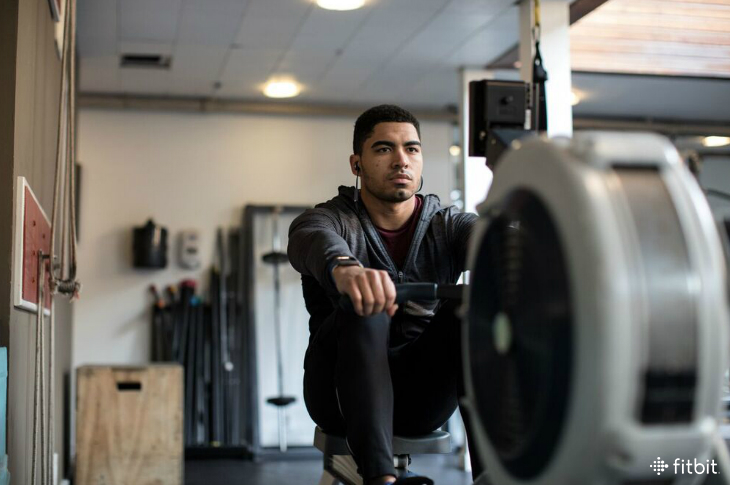
Most of us hit the gym with a loosely outlined plan, say 30 minutes of cardio followed by circuit training on the same six or seven machines. While fitting in any physical activity is better than none, and consistency is key to seeing results, sticking with the same training routine day in and out might mean you’re neglecting some key muscle groups. Not only could this leave you with some weak areas, it may even set you up for sprains and strains.
“When you do the same exercises over and over, you put repetitive stress on your muscles and joints, which could cause injury,” says Pete McCall, a spokesperson for the American Council on Exercise and an ACE-certified personal trainer.
Ready for something new? Here are a few pieces of gym equipment you might have overlooked on your quest for a great total-body workout. The bonus? Most other people aren’t using them either, which means you probably won’t have to wait in line for your turn—even during peak gym hours.
Rowing Machine
For total-body cardiovascular training, few pieces of equipment rival the indoor rowing machine. It engages the big muscles in your legs (quads, hamstrings, glutes) as well as your arms (biceps, triceps), shoulders (lats, traps, and rhomboids), and core. Unlike almost every other cardio machine in the gym, you’re also working those muscles on a vertical as well as horizontal plane, allowing your body to master different movement patterns.
How To Use It:
1. Before starting, check the damper—the lever on the side of the machine that raises or lowers resistance. A good beginner setting is between three and five.
2. Scooch forward in the seat until you can grasp the handles.
3. Drive with your legs first, then lean back slightly until your shoulders pass your hips and pull your arms into your chest.
4. The handles should finish slightly higher than belly-button height. To finish, straighten your arm, lean forwards at the hips, and bend your knees to slide forward.
Sample Workout:
McCall suggests the following 10-minute interval workout to start. Warm up for three minutes, getting used to proper stroke mechanics. Then row for five minutes in a 30-20-10 pattern; that’s 30 seconds easy, 20 seconds picking up the pace, then 10 seconds all-out. End with two minutes of easy rowing. Once you’re comfortable with that workout, try going for 20 or 30 minutes.
Medicine Ball
While no one seems to know exactly where the name “medicine ball” originated, some historians suggest that ancient Greek doctors used animal skins filled with sand as rehabilitation tools. Today, medicine balls are primarily used by athletes looking for a solid core workout that also boosts total-body strength. Research has shown that medicine-ball workouts can improve strength in handball and baseball players, and can also help prevent falls in older adults by boosting balance.
How To Use It:
Medicine balls come in a variety of sizes and weights, but you’re most likely to find one about the size of a soccer ball with a weight of between 10 and 20 pounds. Make sure it’s not too heavy, since the goal is not to struggle to lift it but rather be able to move it over and over again in multiple directions.
Sample Workout:
These moves are a great way to feel comfortable moving the ball.
Lift With Rotation:
1. Stand with your feet shoulder-width apart, right foot slightly in front of your left.
2. Hold the medicine ball by your left hip.
3. Squat down, shifting your hips back. As you stand, move the ball from your left hip to above your right shoulder.
4. Complete two sets of 12 to 15 reps on each side.
Reverse Lunge:
1. Holding the medicine ball at your waist, step your right foot behind you and squat down. Make sure your left knee doesn’t extend past your left food.
2. Return to standing, then repeat stepping your left foot behind you.
3. Complete two sets of 12 to 15 reps on each side.
Squat With Lift:
1. Standing with your feet shoulder-width apart, hold the medicine ball in front of your chest.
2. Squat down, keeping your knees over your feet and shifting your hips back.
3. As you stand up, push the medicine ball overhead until your arms are fully extended. Lower and repeat.
Cable Machine
If you think this piece of exercise equipment is only for elite gym goers, think again. The cable machine can be a great way for beginners to try out new exercises without putting undue stress on their joints, says McCall.
How To Use It:
You’ll see all sorts of attachments lying on or near the cable machine. Don’t be afraid to change them out (the three exercises below use three different ones). It’s also a good idea to start at a low weight, increasing it as you get stronger.
Sample Workout:
As with the medicine ball exercises, do two to three sets of 12 to 15 reps of each of these exercises.
Standing Single-Arm Chest Press
1. Standing in front of a cable station and faced away from the weight rack, grab the D-handle attachment at chest height.
2. With your legs in a staggered stance, stand with your back to the cable machine. Reach behind you and grab the handle with your left hand and return to facing forward. Stand far enough away from the machine that there’s some tension. Your other hand can rest at your side.
3. With your knuckles pointing up and your forearm parallel to the ground, push your left arm forward until it’s fully extended. Then bring it back until your elbow is at your side. Repeat.
Standing Row
1. Attach a straight bar to the pulley at waist height.
2. Facing the machine, use an overhand grip to hold the bar with both hands. Your hands should be roughly shoulder-width apart. Stand far enough away so that there’s some tension.
3. Pull the bar toward your torso while keeping your back straight. Your elbows should stay pointed back and by your sides. Pause, then return to the starting position.
Squat To Row
1. Attach the two-handled rope attachment to the machine at floor height. Stand far away enough from the machine so that there’s some tension.
2. Squat down, bending your knees and shifting your hips back while keeping your back straight.
3. Pushing through your heels, stand back up and pull the cables back, leading with your elbows. You should feel tension in your back as you return the handles to the starting position.
This information is for educational purposes only and is not intended as a substitute for medical diagnosis or treatment. You should not use this information to diagnose or treat a health problem or condition. Always check with your doctor before changing your diet, altering your sleep habits, taking supplements, or starting a new fitness routine.

I remember my first time going to the gym with no idea which machine to use first and how to use them. I couldn’t agree more from what is listed here.
Perhaps Fitbit should include the rowing machine as one of the exercise shortcuts or autorecognized exercises. I do rowing 4 times a week and am not able to record the exercise, distance or split times. If I try to log it instead I am not able to record the distance.
Great informative blog! Thanks for providing detailed insights on the rowing machine, cable machine and medicine balls.